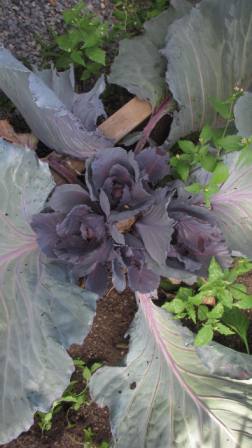by Maria G.
Thinking about growing cabbages in your organic garden this year? This is a cool-weather crop that thrives in the early spring and fall. If you’re reading this in April, you’ve already missed your chance to have organically grown cabbage this gardening season. But don’t worry – September will be here before you know it, and you can try your hand at growing cabbages then.
Starting Cabbage from Seed
You may wish to start from seed rather than purchase small plants. This is because the varieties of cabbage plants available at your local nursery will be limited to the more commonly known types. Growing your own requires planning and takes dedication and attention to detail – but the bounty of shapes, colors and tastes will be worth the extra work.
One benefit of starting cabbages from seed: you can extend the harvest by choosing varieties of cabbage with different days to maturity. For example, you might choose a variety of green cabbage that yields 3 lb. heads which mature in 55 days. Or, you could plant QuickStart cabbages, which grow close and compact to the ground, allowing you to fit more plants into a small space.
Purple cabbage looks beautiful, matures in 75 days, and will add a spark of color to your early spring or fall salad. Savoy cabbage is another good choice – yielding a large head which matures in 95 days. It is sweet and tasty, has crumpled and savoyed leaves.
Even if you only choose just 3 varieties of cabbage to grow in your yard, you can be sure that it will add interest and keep cabbages coming in throughout the season.
Planting your cabbage seeds
Prepare your garden beds by loosening up the earth where necessary, mixing in compost, and smoothing out the soil as needed. Cabbage seeds can be sown directly in your garden beds. Consult the seed packet for explicit instructions.
Typically, cabbage seeds can be planted outside 6 to 8 weeks before the last frost is expected. Since the NJ zone 6 frost danger ends around May 15, you can begin with your cabbage seeds as early as March 15. Your effort will yield an early spring crop. Another option is to put your cabbage seeds in at the end of summer, since this is a plant that prefers cool weather.
Cabbage plant spacing
Plant each seed anywhere from 12 to 24 inches apart, depending on how big you like your cabbage heads to be.
Be sure to go heavy with the compost, as this will regulate the temperature of the soil to promote steady growth.
Warding off cabbage maggots
Protect your young cabbage seedlings by fashioning a little square platform to support each plant. I like to make mine out of the bottom of an orange juice carton.
Cut a square out of the cardboard which is approximately 4 inches. Make a slit that runs from the outside to the center, and then make a hole in the center. Slip the square around the bottom of your cabbage plant’s stem and then slide it in place. This is a great trick to ward off cabbage maggots. The bugs will be unable to reach the roots, and therefore can’t damage your plants.
